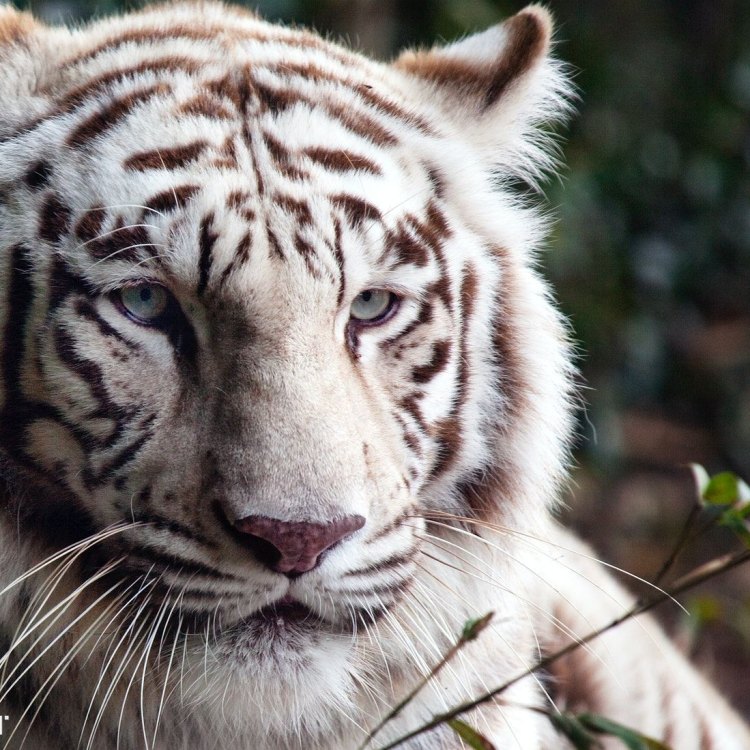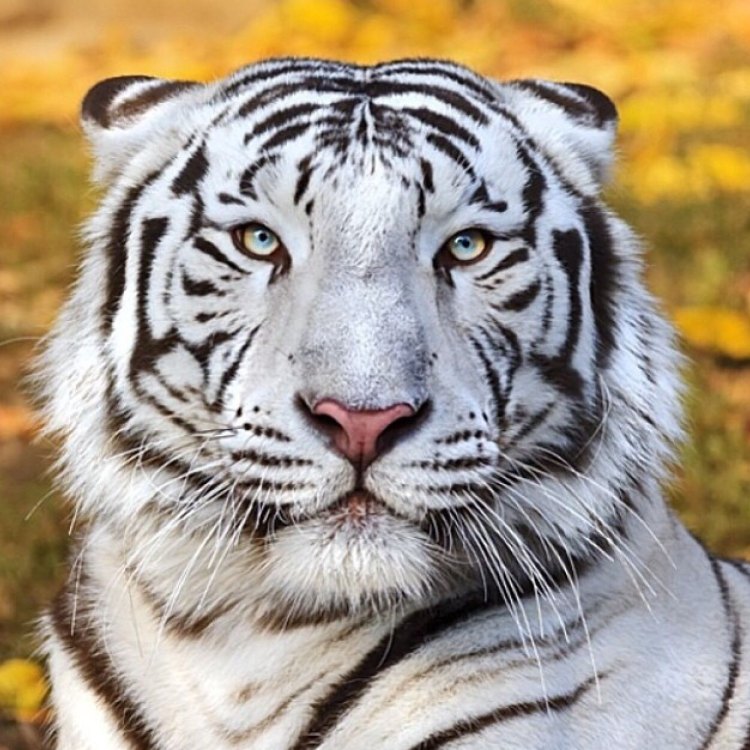
White Tiger
2.2 - 3.1 meters
The magnificent White Tiger, found in India and belonging to the Felidae family, is known for its muscular and agile body shape. With a length of 2.2 - 3.1 meters, this majestic creature is a symbol of strength and beauty. Sadly, their numbers are rapidly declining due to human activities like poaching and habitat loss. Let's do our part in protecting these amazing animals. #WhiteTiger #India #EndangeredSpecies
Animal Details Summary:
Common Name: White Tiger
Kingdom: Animalia
Habitat: Forests, grasslands, and mangrove swamps
The Magnificent White Tiger: An Elusive and Enchanting Creature
The animal kingdom is full of fascinating creatures, each uniquely adapted to their environment. Some are known for their strength, others for their intelligence, and then there are those that captivate us with their sheer beauty. One such species that stands out among the rest is the White Tiger.With its striking white fur and piercing blue eyes, the White Tiger is an iconic symbol of power, grace, and mystery White Tiger. It is a creature that has captured the hearts and imagination of people around the world, but very few are lucky enough to catch a glimpse of this elusive animal in the wild. In this article, we will dive deep into the world of the White Tiger, learning about its origins, habitat, physical characteristics, and more.
A Brief Overview of the White Tiger
Scientifically known as Panthera tigris, the White Tiger is also commonly referred to as the Indian White Tiger, due to its country of origin – India. This majestic animal belongs to the Kingdom Animalia, the Phylum Chordata, and the Class Mammalia. It is a carnivorous creature, belonging to the order Carnivora and the family Felidae – a family that includes other big cats such as lions, leopards, and jaguars.White Tigers are most easily recognized by their distinct coloration – they have white fur with black stripes, in contrast to the traditional orange fur that tigers are known for. This unique coloration is due to a rare genetic mutation that results in a lack of red and yellow pigments in their fur, leaving them with shades of white and cream. It is estimated that only one in every 10,000 tigers carries this recessive gene, making White Tigers a rare sight in the wild.
The Habitat of the White Tiger
White Tigers, like their orange counterparts, are native to the lush and diverse forests of India Wirehaired Pointing Griffon. These forests are located in the southern and eastern regions of India, in the states of Assam, Madhya Pradesh, West Bengal, and Orissa. They have also been spotted in the mangrove swamps of the Sundarbans, a vast coastal forest shared by India and Bangladesh.Within these habitats, White Tigers can be found in a variety of landscapes, including dense forests, grasslands, and mangrove swamps. They are highly adaptive creatures, and their coloration actually provides them with an advantage in the dense forest cover, making it easier for them to camouflage and hunt their prey.
Feeding Habits of the White Tiger
As mentioned earlier, the White Tiger is a carnivorous animal, which means it primarily feeds on meat. In the wild, its diet mainly consists of deer, wild boar, buffalo, and other large herbivores found in their habitat. They are skilled hunters, capable of taking down prey that is much larger than their own size.One of the most unique and impressive qualities of the White Tiger is its ability to hunt both on land and in water. Their powerful muscles, agile bodies, and webbed paws make them excellent swimmers, allowing them to catch prey from both land and water.
The Geographical Distribution and Country of Origin of the White Tiger
As mentioned earlier, the White Tiger's natural habitat is restricted to the Indian subcontinent, making it endemic to the region. However, through conservation efforts and breeding programs, White Tigers have been reintroduced to other parts of the world, such as the United States and China.Despite their successful relocations, the majority of White Tigers still reside in India, making it their country of origin. India has a long and rich history of tigers, and it is regarded as one of the best places in the world to spot these magnificent creatures in the wild.
The Physical Characteristics of the White Tiger
White Tigers are similar in appearance to traditional orange tigers, with the most significant difference being their white fur with black stripes. However, they also have other distinct physical features that set them apart from other big cats.Firstly, White Tigers are incredibly muscular and agile creatures, with long and powerful bodies that can reach up to 3.1 meters in length. They also possess massive paws equipped with sharp claws, which they use for hunting and climbing trees. These paws are also an essential adaptation for their life in the water, as they help them navigate through the rivers and lakes in their habitat.
In terms of weight, White Tigers can range from 150 to 300 kilograms, with male tigers typically being larger and heavier than females. This weight is supported by strong legs and muscular bodies, giving them the strength and speed needed for their hunting and survival.
The Conservation Status of the White Tiger
Like many other species of tigers, White Tigers are listed as critically endangered on the International Union for the Conservation of Nature (IUCN) Red List. The decrease in their population is mainly due to habitat loss, poaching, and the genetic abnormality that causes their unique coloration.Fortunately, India has implemented several conservation efforts to protect the White Tiger and other endangered species. This includes the establishment of protected national parks and reserves, stricter laws against poaching, and breeding programs for captive animals.
In Conclusion
The White Tiger is truly a remarkable creature, both in appearance and behavior. Its striking coloration, impressive hunting abilities, and adaptability make it a symbol of power and grace in the animal kingdom. However, as their population continues to decline, it is our responsibility as humans to protect and preserve these magnificent animals for future generations to experience.If you ever have the chance to see a White Tiger in the wild, count yourself lucky. Remember, they are elusive creatures, but their presence leaves a lasting impression on those lucky enough to witness it. Let us work together to ensure that these beautiful creatures continue to roam the forests of India for generations to come.

White Tiger
Animal Details White Tiger - Scientific Name: Panthera tigris
- Category: Animals W
- Scientific Name: Panthera tigris
- Common Name: White Tiger
- Kingdom: Animalia
- Phylum: Chordata
- Class: Mammalia
- Order: Carnivora
- Family: Felidae
- Habitat: Forests, grasslands, and mangrove swamps
- Feeding Method: Carnivorous
- Geographical Distribution: India
- Country of Origin: India
- Location: India
- Animal Coloration: White fur with black stripes
- Body Shape: Muscular and agile
- Length: 2.2 - 3.1 meters

White Tiger
- Adult Size: 160 - 300 kg
- Average Lifespan: 10 - 15 years
- Reproduction: Sexual
- Reproductive Behavior: Polygamous
- Sound or Call: Roaring
- Migration Pattern: Non-migratory
- Social Groups: Solitary
- Behavior: Nocturnal
- Threats: Habitat loss and poaching
- Conservation Status: Endangered
- Impact on Ecosystem: Keystone species
- Human Use: Zoos and breeding programs
- Distinctive Features: White fur with blue eyes
- Interesting Facts: White tigers are not a separate species, but a color variant of the Bengal tiger.
- Predator: No natural predators

Panthera tigris
The Enigmatic White Tiger: A Keystone Species on the Brink of Extinction
The white tiger, with its striking white fur and piercing blue eyes, has captivated humans for centuries. Revered as a symbol of strength and beauty, it is no wonder that these magnificent animals have been featured in popular culture, from movies to literature. However, behind their enchanting appearance lies a complex and endangered species that few truly understand.Adult white tigers are large, weighing between 160 to 300 kilograms PeaceOfAnimals.Com. They have a lifespan of 10 - 15 years in the wild, and slightly longer in captivity. With their average size and lifespan, one may assume that their reproductive behavior is monogamous. However, as with most big cats, white tigers are polygamous, meaning that one male mates with multiple females. This behavior is essential for the diversity and survival of the species.
One of the distinctive features of white tigers is their striking white fur with blue eyes. Contrary to popular belief, they are not a separate species from their orange counterparts. White tigers are a rare color variant of the Bengal tiger, a species found in the Indian subcontinent. The color change is due to a recessive gene, which can be inherited from both parents, making white tigers extremely rare in the wild.
However, this rarity has made them a highly desirable target for illegal poaching and trade Wirehaired Vizsla. The white tiger's distinctive color has made it a highly sought-after trophy for collectors, leading to a sharp decline in their population. Combined with the destruction and fragmentation of their habitat due to human activities, the white tiger is now listed as an endangered species, with only around 200 remaining in the wild.
But, apart from being an iconic and rare species, why is the decline of white tigers such a significant concern for humans and the ecosystem?
One reason is that white tigers are a keystone species, playing a vital role in maintaining the balance of their ecosystem. As apex predators, they help control the population of herbivores, preventing them from over-foraging and damaging the plants and vegetation. This, in turn, allows for other animals and plants to thrive, ultimately contributing to the overall health of the ecosystem.
But the impact of their disappearance goes beyond the ecosystem. White tigers also hold a significant cultural and economic value to humans. They are considered sacred by some cultures, and their presence in the wild is essential for maintaining the balance of nature. Furthermore, white tigers are a significant tourist attraction, generating revenue for local communities through ecotourism.
However, despite their importance and significance, white tigers continue to face numerous threats, both human-made and natural. Habitat loss and fragmentation due to deforestation and urbanization are the primary cause of their decline. As their natural habitats continue to shrink, white tigers are forced into smaller areas, increasing competition for resources and raising the chances of human-wildlife conflict.
Illegal poaching for their fur and body parts also remains a significant threat. Despite being listed as an endangered species and protected by law, the high demand for their body parts and the lack of enforcement has resulted in continued poaching. The illegal wildlife trade is a multi-billion dollar industry, making it challenging to fully eradicate.
Sadly, the impact of these threats can be seen in the declining population numbers of white tigers. The once widely distributed subspecies of Bengal tiger is now confined to small pockets of forests in India and Bangladesh. With a limited number of individuals left in the wild, the chances of inbreeding and genetic defects increase, further jeopardizing the survival of the species.
The severity of the situation has led to numerous conservation efforts to protect and increase the population of white tigers. One such effort is the establishment of breeding programs and reintroduction of captive-bred individuals into the wild. These programs have been moderately successful, with some white tigers successfully adapting and reproducing in the wild, giving hope for the species' survival.
Zoos also play a crucial role in white tiger conservation. While some may argue that keeping animals in captivity does not contribute to conservation, zoos provide a controlled and safe environment for breeding. Furthermore, the educational and awareness programs conducted by zoos help raise public understanding and support for conservation efforts.
But saving the white tiger requires more than just protecting them from physical threats. It also involves addressing the underlying issue of human-wildlife conflict. This can be achieved through proper land-use planning and involving local communities in conservation efforts. By providing alternative livelihoods and education, people can learn to coexist with white tigers and see the value of protecting them.
In conclusion, the white tiger may be a symbol of strength and beauty, but it is also a symbol of the delicate balance of nature. Its decline is indicative of the larger issue of habitat destruction and poaching, which not only threatens the existence of a species but also impacts the entire ecosystem. We must act now to protect these magnificent animals before it is too late. By working together, we can ensure that future generations will continue to be mesmerized by the enigmatic and majestic white tiger.

The Magnificent White Tiger: An Elusive and Enchanting Creature
Disclaimer: The content provided is for informational purposes only. We cannot guarantee the accuracy of the information on this page 100%. All information provided here may change without prior notice.












